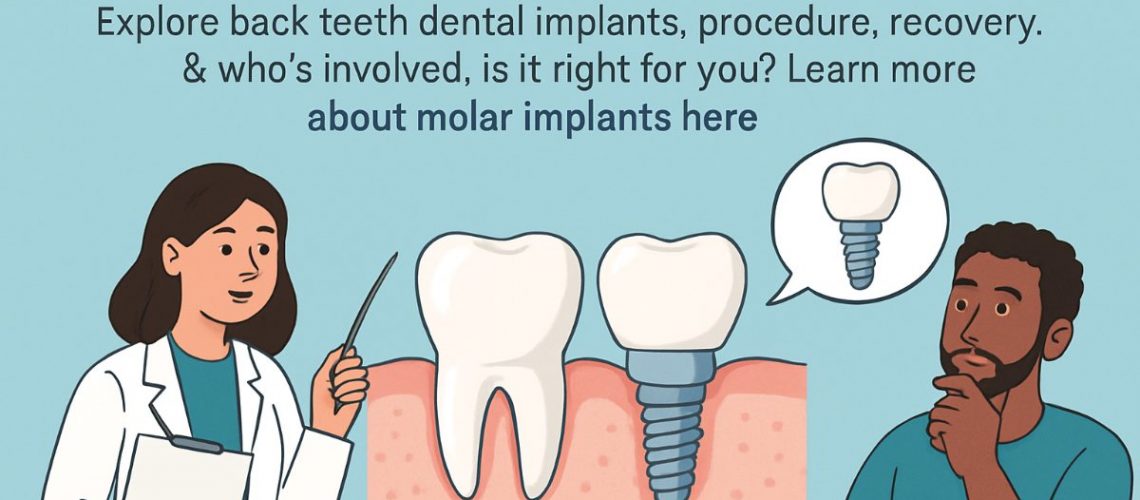If you’ve lost a molar or premolar, you might be wondering if back teeth dental implants are the right solution. Back teeth implants replace the root (a metal post) and the visible tooth (a crown) so you can chew normally and keep neighboring teeth from shifting. Back teeth handle stronger chewing forces than front teeth, so implant planning and strength are critical. This article explains when molar/premolar implants are needed, how the surgery works, who does each part of the treatment, common risks and recovery, and the next steps to get evaluated.
What are back teeth dental implants?
A back teeth dental implant has three main parts: the implant post (titanium screw that goes into the jaw), the abutment (connector), and the prosthetic crown that looks like your tooth. Molars and premolars need crowns and posts built to handle heavy chewing and grinding. Many oral surgeons place the implant post and abutment and then coordinate with your general dentist to make and attach the final crown or bridge.
When do you need back teeth dental implants?
You may need an implant if a missing back tooth makes chewing hard, causes nearby teeth to shift, changes your bite, or if you have repeated infections where the tooth used to be. If a tooth has been missing for a long time, the jawbone may shrink. That bone loss can mean you need extra procedures like a bone graft or a sinus lift before an implant can be placed.
How the surgical process works for molar implants
Consultation and imaging
Your surgeon will review your health, take digital scans and CT images, and map nearby nerves and the sinus floor. CT-guided planning helps pick the right implant size and angle to avoid nerves and sinuses for safer molar implant placement.
Placement of the implant post and abutment
Placement usually involves making a small opening in the gum, drilling into the jaw, and placing the titanium post. In some cases the abutment is placed later after healing. Healing time varies but often takes a few months for the bone to fuse to the implant. IV sedation or general anesthesia options are available to keep you comfortable during the procedure.
Special challenges for back teeth
Upper molars may sit close to the sinus, limiting bone height and sometimes requiring a sinus lift. Lower molars often have very dense bone and large nerves nearby, which can make access and angulation harder. Limited mouth opening and visibility can also complicate surgery. For severe bone loss, techniques like zygomatic implants or advanced grafting may be considered.
The roles: oral surgeon vs general dentist
Oral surgeons commonly place the implant post and manage surgical risks. Your general dentist or prosthodontist typically makes and fits the final crown or bridge. Clear communication ensures the implant fits the planned restoration and the timeline is coordinated between providers.
Risks, recovery, and other oral surgery needs
Short-term risks include swelling, bruising, infection, and temporary nerve irritation. Most patients recover in a few days to weeks, with full bone healing over months. Additional procedures—bone grafts, sinus lifts, or removing wisdom teeth—can change timing. For wisdom tooth extractions or related oral surgery, Dr. McCloy handles those services as part of comprehensive surgical care.
Why choose an experienced oral surgeon for back teeth dental implants
Complex back-tooth cases benefit from CT-guided planning, IV sedation, and a skilled surgical team to reduce complications and improve outcomes. Dr. Edward Halusic is referenced for implant expertise and coordinating implant placement with restorative dentists to achieve predictable results.
Next steps: getting evaluated for back teeth dental implants
Bring any recent dental X-rays, a list of medications, and notes about symptoms to your consultation. Ask who will place the crown, the expected timeline, anesthesia options, and whether grafting is likely. If you’re ready, schedule an evaluation to create a coordinated plan with your dentist and an oral surgeon to restore chewing, comfort, and dental health.

